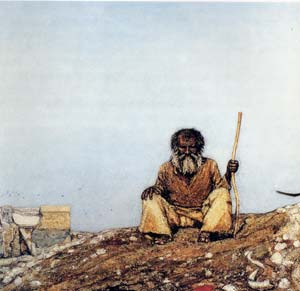Here spent Narcissus, weary of the hunt
And sick with heat, fell to the grass, charmed by
The bright well and its greenery. He bent
To drink, to dissipate his thirst, yet as he
Drank another thirst rose up: enraptured
Beauty caught his eyes that trapped him;
He loved the image that he thought was shadow,
And looked amazed at what he saw—his face.
Ovid’s Metamorphoses; Book III.
Trans. Horace Gregory
In many ways, this is a scatological image. From an equally scatological series that artist Vik Muniz entitled “Pictures of Garbage,” the image of Narcissus is one of life and death. According to Ovid’s account of the myth, the beautiful boy, in the prime of life, found himself wounded by the vision of his own beauty on the surface of a pond, and fell deeply, mortally in love. Refusing nourishment, Narcissus remained entranced in front of the lovely reflection and withered away, fully aware of the incorporeity of his love object and wishing—oddly, for a lover—he could be separated from that image he desired and not be one with it. A lonely flower stood in the place of Narcissus, as a marker of an utterly consumed lover. Narcissus did not love himself as bodyly life, but as a phantasmagoric image on a screen of water.
Scatology deals, after all, in that interstice open between life and death; the same space trash and junk occupy. The limit between life and death in the process of decomposition, as the limit between the body and the image in this myth are just as blurry as are those between a useful commodity and a piece of garbage. Transformation is key in defining garbage; it is, after all, nature metamorphosed by human—not godly—intervention.
The genius of Vik Muniz image is the intricate conections taking place in his picture. It is scatological because it is made with junk, scattered pieces of former machines and other industrial objects, but also because of the myth that is reproducing: the deadly rapture that led to the demise of youg Narcissus, we see the boy withering away. At the same time, Muniz renders a junk version of Caravaggio’s Narcissus, which implies to breed new life into a classical painting, sort of producing a Frankenstein version of a venerated figure in the tradition of painting.





